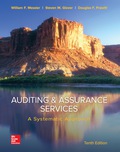
EBK AUDITING & ASSURANCE SERVICES: A SY
10th Edition
ISBN: 9781259293245
Author: Jr
Publisher: MCGRAW HILL BOOK COMPANY
expand_more
expand_more
format_list_bulleted
Question
Chapter 8, Problem 8.18MCQ
To determine
Concept Introduction:
Sampling is the method of selecting few items to check from the entire population under examination. Auditors apply sampling method while performing their
Sampling can be statistical or non statistical.
To choose: the correct statement concerning the statistical sampling in tests of controls.
Expert Solution & Answer
Want to see the full answer?
Check out a sample textbook solution
Students have asked these similar questions
7. If the inflation rate is 3% and the nominal return on an investment is 8%, what is the real return approximately?
A) 5.0%B) 4.9%C) 5.2%D) 6.0%
7. If the inflation rate is 3% and the nominal return on an investment is 8%, what is the real return approximately?
A) 5.0%B) 4.9%C) 5.2%D) 6.0%need help properly.
Which of the following formulas represents compound interest?
A) I = PRTB) A = P(1 + rt)C) A = P(1 + r/n)^(nt)D) A = P - Ineed help!
Chapter 8 Solutions
EBK AUDITING & ASSURANCE SERVICES: A SY
Ch. 8 - Prob. 8.1RQCh. 8 - Prob. 8.2RQCh. 8 - Prob. 8.3RQCh. 8 - Prob. 8.4RQCh. 8 - Prob. 8.5RQCh. 8 - Prob. 8.6RQCh. 8 - Prob. 8.7RQCh. 8 - Prob. 8.8RQCh. 8 - Prob. 8.9RQCh. 8 - Prob. 8.10RQ
Ch. 8 - Prob. 8.11MCQCh. 8 - Prob. 8.12MCQCh. 8 - Prob. 8.13MCQCh. 8 - Prob. 8.14MCQCh. 8 - Prob. 8.15MCQCh. 8 - Prob. 8.16MCQCh. 8 - Prob. 8.17MCQCh. 8 - Prob. 8.18MCQCh. 8 - Prob. 8.19MCQCh. 8 - Prob. 8.20MCQCh. 8 - Prob. 8.21PCh. 8 - Prob. 8.22PCh. 8 - Prob. 8.23PCh. 8 - Prob. 8.24PCh. 8 - Prob. 8.25PCh. 8 - Prob. 8.26PCh. 8 - Prob. 8.27PCh. 8 - Prob. 8.28PCh. 8 - Prob. 8.29PCh. 8 - Prob. 8.30PCh. 8 - Prob. 8.31P
Knowledge Booster
Similar questions
- Which of the following formulas represents compound interest? A) I = PRTB) A = P(1 + rt)C) A = P(1 + r/n)^(nt)D) A = P - Iarrow_forwardA bond pays annual coupons of $60 and is currently priced at $1,050. What is its current yield? A) 6.0% B) 5.7% C) 5.5% D) 5.0% explainarrow_forward8. A bond pays annual coupons of $60 and is currently priced at $1,050. What is its current yield? A) 6.0%B) 5.7%C) 5.5%D) 5.0% helparrow_forward
- 8. A bond pays annual coupons of $60 and is currently priced at $1,050. What is its current yield? A) 6.0%B) 5.7%C) 5.5%D) 5.0%arrow_forwardWhat is the effective annual rate (EAR) if the nominal rate is 12% compounded quarterly? A) 12.55%B) 12.00%C) 12.36%D) 12.82% need help!arrow_forwardWhat is the effective annual rate (EAR) if the nominal rate is 12% compounded quarterly? A) 12.55%B) 12.00%C) 12.36%D) 12.82%arrow_forward
- A loan of $10,000 is to be repaid in equal annual installments over 4 years at 5% interest. What is the annual installment? A) $2,564.57B) $2,856.44C) $2,312.49D) $2,775.60arrow_forward1. What is the simple interest on a loan of $5,000 at 6% per annum for 3 years? A) $900B) $750C) $1,200D) $600arrow_forwardWhat is the monthly payment on a $12,000 loan at 6% annual interest, to be repaid over 1 year? A) $1,030.33B) $1,033.00C) $1,035.45D) $1,050.00need help!!arrow_forward
- What is the monthly payment on a $12,000 loan at 6% annual interest, to be repaid over 1 year? A) $1,030.33B) $1,033.00C) $1,035.45D) $1,050.00arrow_forward4. A stock pays an annual dividend of $3 and is currently priced at $60. What is the dividend yield? A) 4%B) 5%C) 6%D) 3%arrow_forward4. A stock pays an annual dividend of $3 and is currently priced at $60. What is the dividend yield? A) 4%B) 5%C) 6%D) 3%need help!!arrow_forward
arrow_back_ios
SEE MORE QUESTIONS
arrow_forward_ios
Recommended textbooks for you
 Auditing: A Risk Based-Approach to Conducting a Q...AccountingISBN:9781305080577Author:Karla M Johnstone, Audrey A. Gramling, Larry E. RittenbergPublisher:South-Western College Pub
Auditing: A Risk Based-Approach to Conducting a Q...AccountingISBN:9781305080577Author:Karla M Johnstone, Audrey A. Gramling, Larry E. RittenbergPublisher:South-Western College Pub Auditing: A Risk Based-Approach (MindTap Course L...AccountingISBN:9781337619455Author:Karla M Johnstone, Audrey A. Gramling, Larry E. RittenbergPublisher:Cengage Learning
Auditing: A Risk Based-Approach (MindTap Course L...AccountingISBN:9781337619455Author:Karla M Johnstone, Audrey A. Gramling, Larry E. RittenbergPublisher:Cengage Learning

Auditing: A Risk Based-Approach to Conducting a Q...
Accounting
ISBN:9781305080577
Author:Karla M Johnstone, Audrey A. Gramling, Larry E. Rittenberg
Publisher:South-Western College Pub

Auditing: A Risk Based-Approach (MindTap Course L...
Accounting
ISBN:9781337619455
Author:Karla M Johnstone, Audrey A. Gramling, Larry E. Rittenberg
Publisher:Cengage Learning